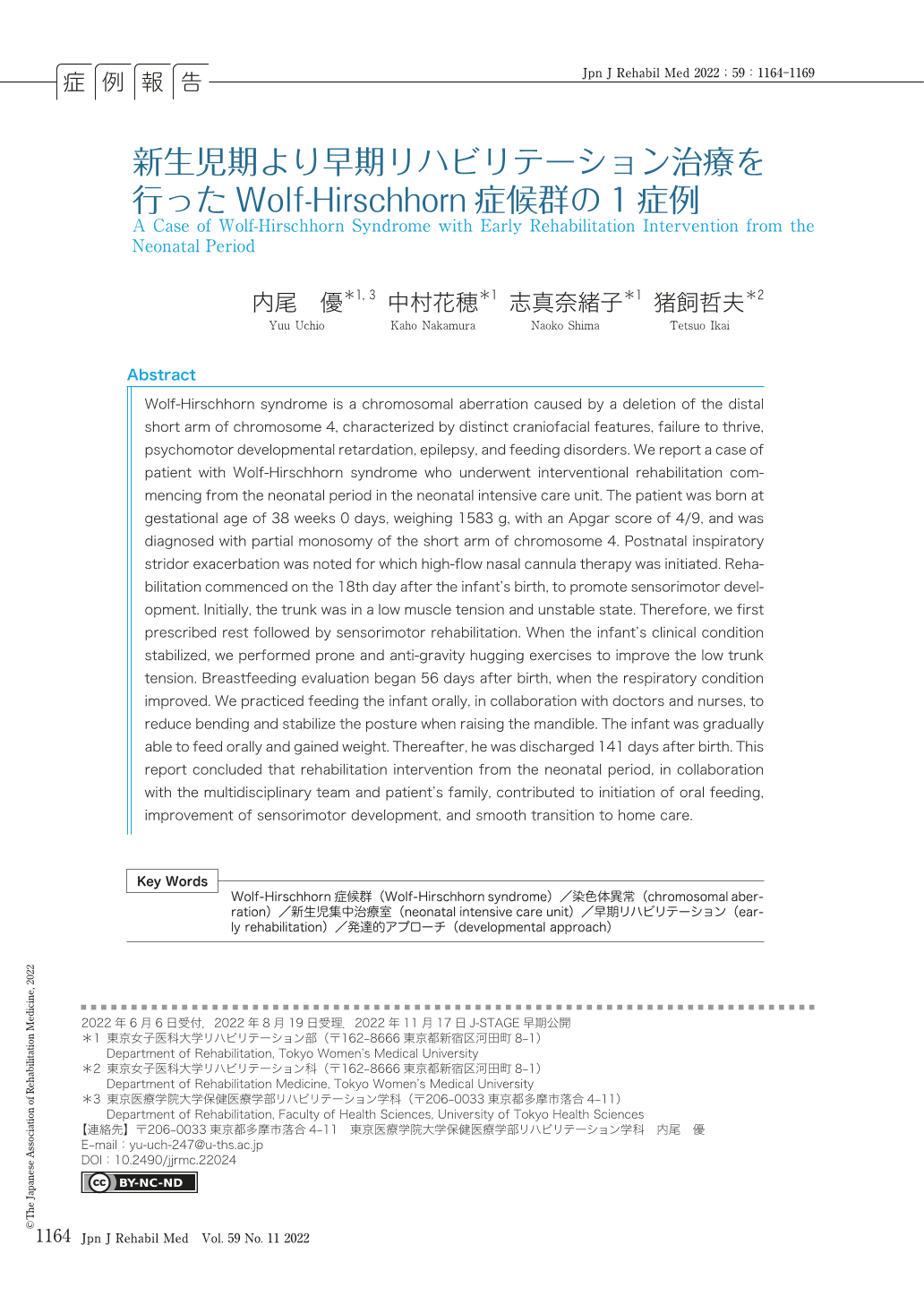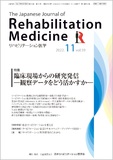Japanese
English
- 販売していません
- Abstract 文献概要
- 1ページ目 Look Inside
- 参考文献 Reference
はじめに
Wolf-Hirschhorn症候群(Wolf-Hirschhorn syndrome:WHS)は,4番染色体短腕遠位部欠失に起因する染色体異常症候群であり,特異的顔貌,成長障害,精神運動発達遅滞,てんかんを主症状とし,哺乳摂食障害,生前生後の発育遅滞,先天性心疾患を合併する1).発生頻度は,1/20,000〜50,000であり,女児に多い2).発達予後は,約45%が2〜12歳で歩行が可能になるが,精神運動発達遅滞は必発かつ重度である3).また,新生児期・乳児期の早期には呼吸や哺乳障害などが問題となることが多いため,出生後早期からの継続した発達的アプローチが必要である.
WHSにおける健康管理ガイドラインにおいても運動発達や摂食に対するリハビリテーション治療が推奨されているものの4),本邦においてWHSに対する早期リハビリテーション治療の報告は検索する限り見当たらない.
当院は3次救急を含む急性期病院であり,新生児集中治療室(neonatal intensive care unit:NICU)に入院した出生体重1,500g未満の児や神経学的異常・発達の遅延の可能性がある児に対しては,全例リハビリテーション診断・治療を行っている.今回,WHSによりNICUでの治療を要し,新生児期の早期から運動発達支援,哺乳評価・介入を行うことにより,円滑な退院に至ったと考えられた症例を経験したので報告する.なお,本報告において代諾者である患者の両親へ本発表の趣旨,内容について文書および口頭にて十分な説明を行い,書面にて了承を得た.
Abstract
Wolf-Hirschhorn syndrome is a chromosomal aberration caused by a deletion of the distal short arm of chromosome 4, characterized by distinct craniofacial features, failure to thrive, psychomotor developmental retardation, epilepsy, and feeding disorders. We report a case of patient with Wolf-Hirschhorn syndrome who underwent interventional rehabilitation commencing from the neonatal period in the neonatal intensive care unit. The patient was born at gestational age of 38 weeks 0 days, weighing 1583 g, with an Apgar score of 4/9, and was diagnosed with partial monosomy of the short arm of chromosome 4. Postnatal inspiratory stridor exacerbation was noted for which high-flow nasal cannula therapy was initiated. Rehabilitation commenced on the 18th day after the infant's birth, to promote sensorimotor development. Initially, the trunk was in a low muscle tension and unstable state. Therefore, we first prescribed rest followed by sensorimotor rehabilitation. When the infant's clinical condition stabilized, we performed prone and anti-gravity hugging exercises to improve the low trunk tension. Breastfeeding evaluation began 56 days after birth, when the respiratory condition improved. We practiced feeding the infant orally, in collaboration with doctors and nurses, to reduce bending and stabilize the posture when raising the mandible. The infant was gradually able to feed orally and gained weight. Thereafter, he was discharged 141 days after birth. This report concluded that rehabilitation intervention from the neonatal period, in collaboration with the multidisciplinary team and patient's family, contributed to initiation of oral feeding, improvement of sensorimotor development, and smooth transition to home care.

Copyright © 2022, The Japanese Association of Rehabilitation Medicine. All rights reserved.


